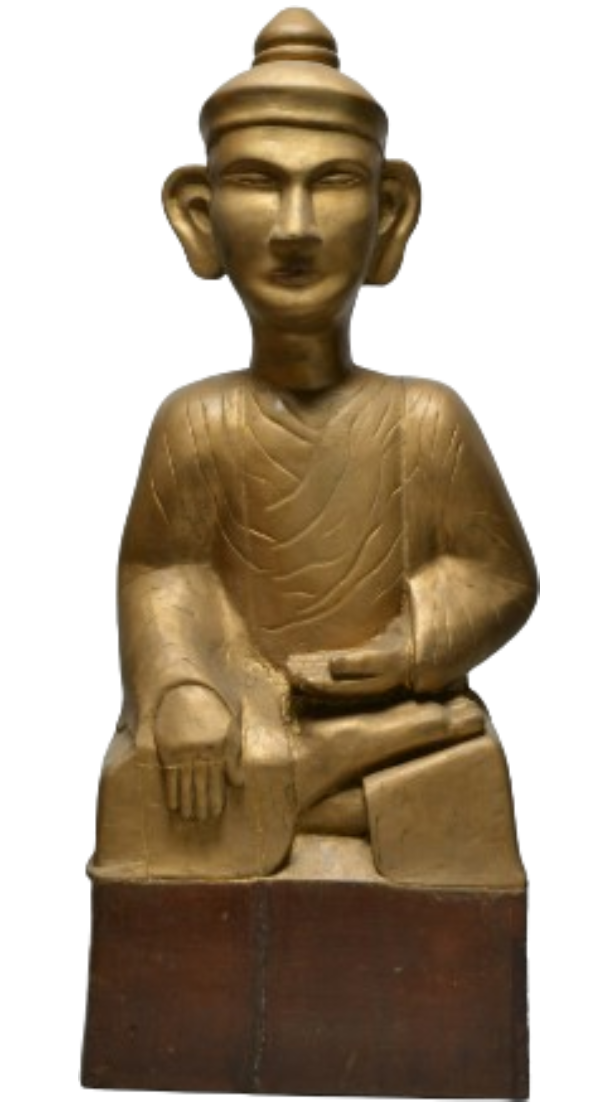State
Tribe Name
Art Type
short description
The sculpture of a seated Buddha represents the spirituality of Buddhism, demonstrating the craftsmanship of its tradition. The Khampti tribe has created this sculpture. Mostly Khamptis live in Arunachal Pradesh and Assam, and believe in the tenets of Theravada Buddhism. Artistry and handicraft of Khamptis have strong attachments to their own religious faith. The sculpture is made as a result of carving, with the Buddha, Bhumi-Sparsha Mudra, as the image at the very moment of his enlightenment under the Bodhi tree. Bhumi-Sparsha Mudra, or earth-touching gesture, indicates victory over worldly temptations, with the right hand extended toward the ground while the left rests upon the lap, and the act of meditation.
Khampti artisans are known by their wood-carving art using local material teak and sandalwood in fine detail that is long-lasting. These sculptures are richly carved, not only on the drapery and facial features but also on the lotus pedestal, all of which stand as living examples of master craftsmanship. These sculptures of Buddha are often housed in monasteries and temples and individual shrines make them sacred objects of meditation and worship.
With a very few artisans keeping the culture of carving alive, the Khampti still have their carving traditions somehow carried on despite very few artisans keeping alive the tradition. This has thus kept the culture intact.
With their continued practice of such meticulous craftsmanship, the Khampti artisans uphold both their spiritual and artistic legacy; that is, passing their traditional skills on to generations to come and strengthening their very roots in the Buddhist faith.
Khampti artisans are known by their wood-carving art using local material teak and sandalwood in fine detail that is long-lasting. These sculptures are richly carved, not only on the drapery and facial features but also on the lotus pedestal, all of which stand as living examples of master craftsmanship. These sculptures of Buddha are often housed in monasteries and temples and individual shrines make them sacred objects of meditation and worship.
With a very few artisans keeping the culture of carving alive, the Khampti still have their carving traditions somehow carried on despite very few artisans keeping alive the tradition. This has thus kept the culture intact.
With their continued practice of such meticulous craftsmanship, the Khampti artisans uphold both their spiritual and artistic legacy; that is, passing their traditional skills on to generations to come and strengthening their very roots in the Buddhist faith.
Thumbnail

Filter Postion
Right
Filter Background
Off
Theme
Filter Header Image

content
Image

description
The sculpture of a seated Buddha represents the spirituality of Buddhism, demonstrating the craftsmanship of its tradition. The Khampti tribe has created this sculpture. Mostly Khamptis live in Arunachal Pradesh and Assam, and believe in the tenets of Theravada Buddhism. Artistry and handicraft of Khamptis have strong attachments to their own religious faith. The sculpture is made as a result of carving, with the Buddha, Bhumi-Sparsha Mudra, as the image at the very moment of his enlightenment under the Bodhi tree. Bhumi-Sparsha Mudra, or earth-touching gesture, indicates victory over worldly temptations, with the right hand extended toward the ground while the left rests upon the lap, and the act of meditation.
Khampti artisans are known by their wood-carving art using local material teak and sandalwood in fine detail that is long-lasting. These sculptures are richly carved, not only on the drapery and facial features but also on the lotus pedestal, all of which stand as living examples of master craftsmanship. These sculptures of Buddha are often housed in monasteries and temples and individual shrines make them sacred objects of meditation and worship.
With a very few artisans keeping the culture of carving alive, the Khampti still have their carving traditions somehow carried on despite very few artisans keeping alive the tradition. This has thus kept the culture intact.
With their continued practice of such meticulous craftsmanship, the Khampti artisans uphold both their spiritual and artistic legacy; that is, passing their traditional skills on to generations to come and strengthening their very roots in the Buddhist faith.
Khampti artisans are known by their wood-carving art using local material teak and sandalwood in fine detail that is long-lasting. These sculptures are richly carved, not only on the drapery and facial features but also on the lotus pedestal, all of which stand as living examples of master craftsmanship. These sculptures of Buddha are often housed in monasteries and temples and individual shrines make them sacred objects of meditation and worship.
With a very few artisans keeping the culture of carving alive, the Khampti still have their carving traditions somehow carried on despite very few artisans keeping alive the tradition. This has thus kept the culture intact.
With their continued practice of such meticulous craftsmanship, the Khampti artisans uphold both their spiritual and artistic legacy; that is, passing their traditional skills on to generations to come and strengthening their very roots in the Buddhist faith.
Image Mode
portrait
promoted
Off
Verified
Off
